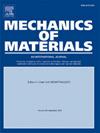一种不确定性量化指导的高速撞击高级陶瓷建模方法
IF 3.4
3区 材料科学
Q2 MATERIALS SCIENCE, MULTIDISCIPLINARY
引用次数: 0
摘要
高级陶瓷通常用作冲击应用中保护结构的组件。提高这些材料的冲击性能是复杂的,因为其性能取决于在多个时间和长度尺度上运行的多种破坏机制。所涉及的机制可以随着撞击点和撞击后时间的位置而变化,包括微裂纹和随后的弹性性能退化,以及非晶化和/或晶格塑性。此外,材料也可能被粉碎,并在某些区域经历颗粒流动。模拟先进陶瓷的冲击性能的一种方法是通过结合底层物理的基于机制的模型。这种方法为改进性能的材料设计提供了指导,但是这种模型通常涉及大量的输入参数,很难在计算求解器中实现,并且从计算的角度来看可能非常昂贵。相比之下,现象学模型具有简单和计算效率高的优点,但需要与微观结构无关的拟合参数,因此从材料设计的角度来看效果较差。此外,先进陶瓷材料的加工可以引入随机异质性(晶格,晶粒尺度和更大的缺陷),这反过来又会引入实验结果的变化和相关的不确定性。在这项研究中,我们首先将基于机制的模型的物理输入参数与现象学模型的参数联系起来,并量化不确定性,因为它在两个模型的参数集之间传播。为此,构建了基于神经网络的具体冲击模拟代理。然后利用具有不确定参数的现象学模型进行模拟,得到了冲击性能指标的不确定性。因此,我们通过现象学参数对基于机构的模型在大参数空间上的冲击性能进行了敏感性分析。这样的分析可以证明在材料选择和指导加工方法更好的材料设计有用。本文章由计算机程序翻译,如有差异,请以英文原文为准。
An uncertainty quantification guided approach to modeling high-velocity impact into advanced ceramics
Advanced ceramics are often used as components of protective structures for impact applications. Improving the impact performance of these materials is complicated, because the performance depends on multiple failure mechanisms operating at several time- and length-scales. The mechanisms involved can change with location with respect to the impact point and the time after impact, and include micro-cracking and subsequent degradation of elastic properties, as well as amorphization and/or lattice plasticity. In addition, the material may also be comminuted and experience granular flow in some regions. One approach to simulating the impact performance of advanced ceramics has been through mechanism-based models that incorporate the underlying physics. Such an approach provides guidance with respect to materials design for improved performance, but such models often involve large numbers of input parameters, can be hard to implement in computational solvers, and can be very expensive from a compute-viewpoint. In contrast, phenomenological models offer the advantages of simplicity and computational efficiency but require fitting parameters that are not tied to microstructure, and therefore are less effective from a materials design perspective. Further, the processing of advanced ceramic materials can introduce stochastic heterogeneities (lattice, grain scale and larger defects) which in turn, introduce variations in experimental results and associated uncertainty. In this study we first connect the physical input parameters of a mechanism-based model to the parameters of a phenomenological model, and quantify the uncertainty as it propagates across the parameters sets of the two models. Neural-network based surrogates of specific impact simulations are constructed to accomplish this. The uncertainty in an impact performance metric is then obtained from simulations-surrogates using the phenomenological model with uncertain parameters. As a result, we obtain sensitivity analysis of impact performance over the large parameter space of the mechanism-based model via the phenomenological parameters. Such analyses can prove useful in material selection and also guide processing methodologies for better material design.
求助全文
通过发布文献求助,成功后即可免费获取论文全文。
去求助
来源期刊

Mechanics of Materials
工程技术-材料科学:综合
CiteScore
7.60
自引率
5.10%
发文量
243
审稿时长
46 days
期刊介绍:
Mechanics of Materials is a forum for original scientific research on the flow, fracture, and general constitutive behavior of geophysical, geotechnical and technological materials, with balanced coverage of advanced technological and natural materials, with balanced coverage of theoretical, experimental, and field investigations. Of special concern are macroscopic predictions based on microscopic models, identification of microscopic structures from limited overall macroscopic data, experimental and field results that lead to fundamental understanding of the behavior of materials, and coordinated experimental and analytical investigations that culminate in theories with predictive quality.
 求助内容:
求助内容: 应助结果提醒方式:
应助结果提醒方式:


